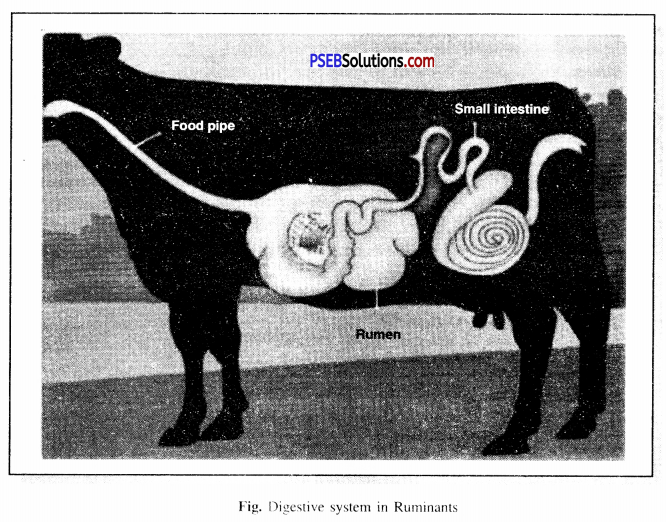Punjab State Board PSEB 7th Class Science Book Solutions Chapter 2 Nutrition in Animals Textbook Exercise Questions and Answers.
PSEB Solutions for Class 7 Science Chapter 2 Nutrition in Animals
Science Guide for Class 7 PSEB Nutrition in Animals Intext Questions and Answers
Think and Answer (Textbook Page No. 12)
Question 1.
Name the solution secreted by the Salivary glands of mouth.
Answer:
The saliva Juice is released by the salivary glands in the mouth.
Question 2.
What changes are seen in starch on adding iodine solution ?
Answer:
Post-iodine solution added to starch iodine solution turns purple or blue.
![]()
Question 3.
In which form the starch is converted after digestion in mouth ?
Answer:
Saliva is released by the salivary glands in the mouth which contains an enzyme called amylase. This enzyme converts starch into sugar.
Think and Answer (Textbook Page No. 13)
Question 1.
Give other name for cutting teeth.
Answer:
Incisors are also called sharp teeth.
Question 2.
Which age group has both premolars and molars ?
Answer:
Pre-molar and molar teeth begin to break at the age of 50 years and above.
Question 3.
What is the maximum number of teeth present in an adult ?
Answer:
Adults over the age of 30 have a total of 32 teeth of all types in their mouths.
Think and Answer (Textbook Page No. 14)
Question 1.
At which region of the tongue sour taste is felt ?
Answer:
At around 3/4th part of the tongue from the starting i.e. a bit ahead of middle of the tongue the sour taste is experienced.
Question 2.
Why don’t we feel bitter taste at front part of the tongue ?
Answer:
The front part of tongue is free to move in all directions and this part only helps in chewing food and mixing saliva. The four glands on tongue are sweet, salty, sour and a little. Only sweet taste is experienced in the front part of the tongue whereas bitter taste is experienced in the last part of the tongue.
PSEB 7th Class Science Guide Nutrition in Animals Textbook Questions and Answers
1. Fill in the Blanks:
(i) The animals that eat both plants as well as animals are called ………………..
Answer:
omnivorous
(ii) ……………… of the food in human beings start in mouth and is completed in the ……………. .
Answer:
digestion, small intestine
(iii) ………………… is the largest gland in human beings.
Answer:
liver
![]()
(iv) The large intestine absorb excess ………………… and ……………… from undigested food
Answer:
excess water, salt
2. State True or False:
(i) The tongue helps in mixing of food with saliva.
Answer:
True
(ii) In a humans digestion is completed in the stomach.
Answer:
False
(iii) Cud chewing animals are called ruminants.
Answer:
True
(iv) Amoeba captures food particles with the help of pseudopodia.
Answer:
False
3. Match the Column ‘A’ with Column ‘B’:
| Column ‘A’ | Column ‘B’ |
| 1. Ruminant | (a) Bile |
| 2. Carbohydrates | (b) Store undigested food |
| 3. Gall bladder | (c) Glucose |
| 4. Small intestine | (d) Cow |
| 5. Rectum | (e) Digestion is completed |
Answer:
| Column ‘A’ | Column ‘B’ |
| 1. Ruminant | (d) Cow |
| 2. Carbohydrates | (c) Glucose |
| 3. Gall bladder | (a) Bile |
| 4. Small intestine | (e) Digestion is completed |
| 5. Rectum | (b) Store undigested food |
4. Choose the Correct Answer:
Question (i)
Animals that eat only plants are called:
(a) Carnivores
(b) Herbivores
(c) Omnivores
(d) Saprophytes
Answer:
(b) Herbivorous.
![]()
Question (ii)
Extracellular digestion occurs in:
(a) Parasites
(b) Carnivores
(e) Saprophytes
(d) Herbivores
Answer:
(e) Saprophytes.
Question (iii)
The process of taking food into the body is called:
(a) Ingestion
(b) Digestion
(e) Absorption
(ri) Egestion
Answer:
(a) Ingestion.
Question (iv)
Secretion of Liser is:
(a) Proteins
(b) Bile
(c) Carbohydrates
(d) Saliva
Answer:
(b) Bile.
Question (v)
Nutrition in Amoeba is:
(a) Parasitic
(b) Holozoic
(c) Saprophytic
(d) Assimilation
Answer:
(c) Saprophytic.
5. Very Short Answer Type Questions:
Question (i)
What is holozoic nutrition ?
Answer:
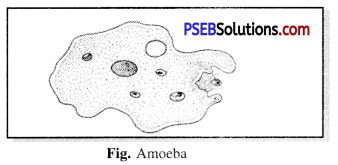
Holozoic nutrition. During this type of nutrition Complex food is taken into the body and then broken down into simple soluble compounds with the help of enzymes; which are absorbed by the body, e.g. Amoeba, human,etc.
Question (ii)
What do you mean by absorption ?
Answer:
Absorption.
During this process the digested food is absorbed through the walls of the small intestine. After this the digested food goes into the blood vessels. On the inner walls of the small intestine, there are a large number of eruptions, called Villi. These finger like projections increase the absorption area of intestine.
Question (iii)
Define assimilation.
Answer:
Automation. Food absorbed by intestine reaches different parts of the body through the blood. This is called Automation.
Question (iv)
Name the parts of alimentary canal.
Answer:
The different parts of the Digestive system are as follows:
- Oral cavity
- Food Pipe
- Stomach
- Small intestine
- Large intestine
- Rectum
- Anus.
![]()
6. Short Answer Type Questions:
Question (i)
What do you mean by milk teeth and permanent teeth ?
Answer:
(a) Milk teeth. Two sets of teeth develop during a person’s lifetime. The first set consists of 20 small teeth, also called milk teeth. They grow during infancy and break down at 6 and 8 years of age.
(b) Permanent Teeth. Between the ages of 6 to 8 years, permanent teeth (32) appear after the fall of the milk teeth. Permanent teeth begin to fall out between the ages of 50 and 60.
Question (ii)
Write four types of human teeth and their functions.
Answer:
The four types of teeth found in post-humans and the four types of teeth found in functional humans are given below:
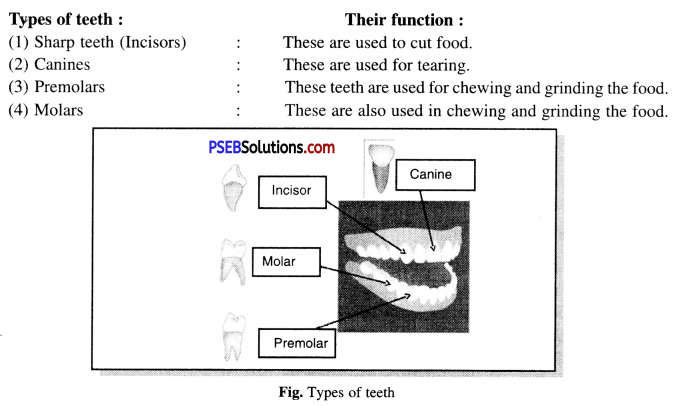
7. Long Answer Type Questions:
Question (i)
Explain nutrition in Amoeba with the help of a diagram.
Answer:

Amoeba.
Amoeba is a microscopic single celled organism found in pond water. It has a cell membrane, a rounded, dense nucleus and many small bubbles- like vacuoles. Amoeba constantly changes it’s shape and position. It moves with it’s virtual feet (called pseudopodia).These are finger like structures which help in movement. During food intake, the membrane between the two virtual legs melts around the food and the food particle get trapped into a vacuole and there is a leakage of enzymes inside it, which break it down in simpler substances from which nutrients are absorbed. Undigested food particles are abandoned by a similar process.
Question (ii)
label the following diagrams:
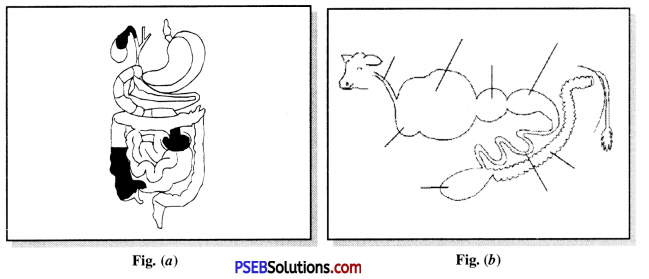
Answer:
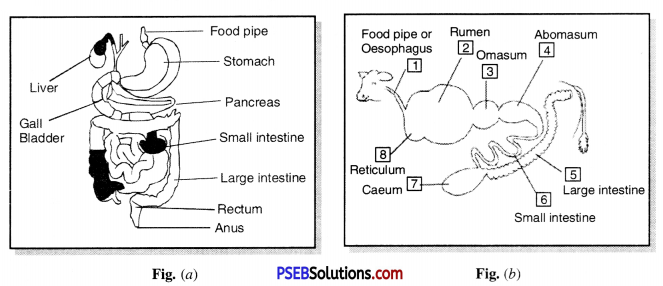
![]()
PSEB Solutions for Class 7 Science Nutrition in Animals Important Questions and Answers
1. Fill in the Blanks:
(i) The main steps of digestion in humans are ……………, ……………, ………….., ………… and ………… .
Answer:
ingestion, digestion, absorption, assimilaton, egestion
(ii) The largest gland in human body is ………………
Answer:
liver
(iii) The stomach releases hydrochloric acid and ………………. juices which act on food.
Answer:
digestive
(iv) The inner wall of small intestine has many finger like outgrowths called ……………… .
Answer:
villi
(v) Amoeba digests its food in the …………… .
Answer:
food vacuole
2. State True or False:
(i) Digestion of starch starts in the stomach.
Answer:
False
(ii) The tongue helps in mixing food with saliva.
Answer:
True
(iii) The gall bladder temporarily stores bile.
Answer:
True
![]()
(iv) The ruminants bring back swallowed grass into their mouth and chew it for some time.
Answer:
True
3. Match the Column I with Column II:
| Column I (Food Components) | Column II (Products of Digestion) |
| 1. Carbohydrate | (a) Fatty acids and glycerol |
| 2. Proteins | (b) Sugar |
| 3. Fats | (c) Amino acids. |
Answer:
| Column I (Food Components) | Column II (Products of Digestion) |
| 1. Carbohydrate | (b) Sugar |
| 2. Proteins | (c) Amino acids |
| 3. Fats | (a) Fatty acids and glycerol. |
4. Multiple Choice Questions:
Question (i)
Name the process of breaking down of complex substances of food into simpler forms.
(a) Assimilation
(b) Ingestion
(c) Digestion
(d) Egestion.
Answer:
(c) Digestion.
Question (ii)
Name the largest digestive gland of human beings ?
(a) Salivary
(b) Pancreas
(c) Liver
(d) Intestinal.
Answer:
(c) Liver.
Question (iii)
Which acid kills bacteria in stomach ?
(a) Sulphuric
(b) Nitric
(c) Hydrochloric
(d) Phosphoric.
Answer:
(c) Hydrochloric.
Question (iv)
Of the following, in which animal rumen is found?
(a) Cow
(b) Dog
(c) Lion
(cI) Cheetah.
Answer:
(a) Cow.
Question (v)
What is the length of small intestine?
(a) 10.5 m
(b) 4 m
(c) 3 m
(d) 7.5 m.
Answer:
(d) 7.5 m.
![]()
Question (vi)
Movement of food in alimentary canal is called:
(a) Locomotion
(b) Pumping
(c) Peristalsis
(d) Sliding.
Answer:
(c) Peristalsis.
Question (vii)
Which is the simplest carbohydrate?
(a) Glucose
(b) Sucrose
(c) Starch
(d) All of the above.
Answer:
(a) Glucose.
Question (viii)
Where is Saliva produced?
(a) Stomach
(b) Pancreas
(c) Salivary Glands
(d) None of the above.
Answer:
(c) Salivary Glands.
Very Short Answer Type Questions
Question 1.
What is food pipe ?
Answer:
Food pipe. It consists of orla cavity oesophagus, stomach, small intestine, large intestine, anus etc.
Question 2.
Write the names of digestive glands.
Answer:
- Salivary glands
- Liver
- pancreas.
Question 3.
What are the different parts of the digestive system ?
Answer:
Digestive juices and food pipe.
Question 4.
When does temporary or milk teeth fall ?
Answer:
Upto the age of six or eight years.
![]()
Question 5.
What is length of small intestine ?
Answer:
7.5 metre (approx.)
Question 6.
What length of large intestine ?
Answer:
1.5 metre (approx.)
Question 7.
Name different types of teeth found in human body.
Answer:
Canines, Incisors, Molars, Premolars.
Question 8.
Which teeth are for cutting and bitting ?
Answer:
Incisors.
Question 9.
Which teeth help in tearing the flesh of prey in animals ?
Answer:
Canines.
Question 10.
What is function of molars and premolars ?
Answer:
Chewing and grinding.
Question 11.
What is tongue ?
Answer:
Tongue. Tongue is a fleshy part of body.
Question 12.
How does tongue taste ?
Answer:
With the help of taste buds.
![]()
Question 13.
What food items are responsible for tooth decay ?
Answer:
Chocolates, Cold drinks, Sweets etc.
Question 14.
Which acid present in stomach kills germs ?
Answer:
Hydrochloric acid.
Question 15.
Which component of food is broken down by saliva in mouth ?
Answer:
Starch.
Short Answer Type Questions
Question 1.
What is Villi ? Where are they present and what are their functions?
Answer:
Villi. Finger-like raised structures in the inner wall of the small intestine are called villi. These are found in the small intestine. Its main function is to absorb digested food.
Question 2.
Where is bile juice made ? Which food components are digested by it?
Answer:
Bile juice is made in the liver and accumulates temporarily in the gallbladder. Its main function is to digest fats.
Question 3.
Write the name of the carbohydrate which is digested by Ruminants but not by humans. Also give reason.
Answer:
Cellulose can be easily digested by Ruminant. A type of bacterium that helps in the digestion of cellulose is found in a sac between the small and large intestines in the rumen of ruminants only. This is the reason humans cannot digest cellulose.
Question 4.
What is the reason that we get energy from glucose immediately?
Answer:
Glucose is a simple form of carbohydrate that is easily absorbed by the body. It dissolves easily in the blood and gives energy immediately.
![]()
Question 5.
Which part of the digestive canal is involved in:
(i) Absorption of food …………. .
(ii) Chewing of food ………………. .
(iii) Killing of bacteria ……………. .
(iv) Complete digestion of food …………… .
(v) Formation of faeces ……………….. .
Answer:
(i) Small intestine
(ii) Buccal cavity
(iii) Stomach
(iv) Small intestine
(v) Large intestine.
Question 6.
Write one similarity and one difference between the nutrition in amoeba and human beings.
Answer:
Similarity in the nutrition in amoeba and human beings:
(a) Digestion of food
(b) Release of energy
Difference in nutrition in amoeba and human beings.
Human beings have a well developed digestive system while amoeba has only food vacuole for digestion.
Question 7.
Can we live only by eating vegetable/grass ? Discuss.
Answer:
Raw green vegetables are rich source of minerals, cellulose and vitamins etc. Apart from, this body needs carbohydrates, fats and proteins. So only vegetables can not provide all these for sustaining etc.
Question 8.
What is digestion and what are its main objectives?
Answer:
The breakdown or conversion of complex foods into simple foods is called digestion.
Purpose of Digestion.
- Breaking of large particles into smaller particles so that they can pass through the
membranes. - Conversion of insoluble substances into soluble substances so that the solution can reach all the places.
- Complete conversion of complex foods into simple substances so that they can be absorbed by cells.
Question 9.
What is a tooth cavity and why does it occur ?
Answer:
Tooth cavity and toothache. By eating too much sweets and not keeping our teeth clean, we invite bacteria which causes damage to our teeth. If we do not keep our teeth clean, food particles get stuck in the teeth and by attacking them, the bacteria start decomposing the food particles which results in the formation of acid. This acid destroys tooth enamel and causes tooth decay. So we should always brush our teeth after eating food and sweets.
Long Answer Type Questions
Question 1.
Describe the digestive system of man.
Answer:
The digestive system of man includes the following organs :
- Mouth. The mouth is first part of food pipe. It contains tongue, teeth and salivary glands. The tongue tastes the food. The salivary glands secrete saliva which lubricates the food. The teeth break the solid food into smaller fragments.
- Oesophagus. It is a tubular structure from mouth to stomach. It takes the food from mouth to stomach.
- Small intestine. It is a coiled tube and is the longest part of food pipe. The digestion of food is completed here with the help of enzymes present in the secretions of liver and pancreas.
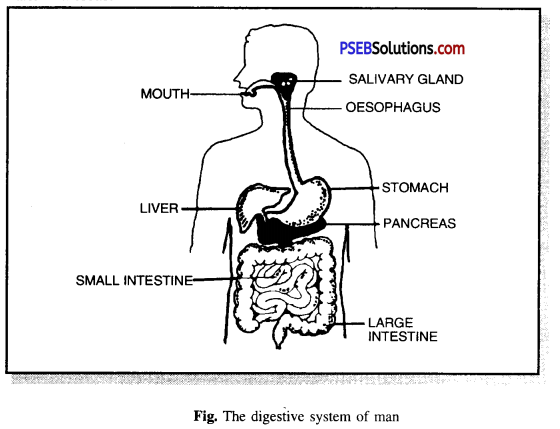
- Large intestine. It absorbs water. The undigested food or faecal matter is stored temporarily and finally removed from the body through the anus.
Question 2.
What is the process of Rumination? How is digestion done in Ruminants? Explain.
Answer:
Rumination. Grass-eating animals chew the cud and are called Ruminants. Cows, buffaloes, camels, and deer are a few examples. Their stomach is made up of four cells. The first cell is the rumen, which is the largest part of the stomach. The animal first swallows the food and stores it in the rumen. This half-digested food is called cud. Later, the cud returns to the animal’s mouth in the form of small lumps and the animal continues to chew it slowly. This process is called rumination. Such animals are called ruminants.
During rumination, the cellulose in the food breaks down into simple compounds. It is then digested in liquid form in the other three cells. The esophagus of ruminant animals has a sac-like structure between the small intestine and the large intestine called the Caecum, where there are some bacteria that help digest grass straw.
